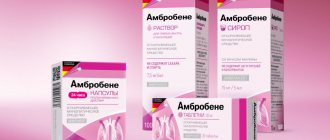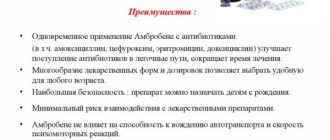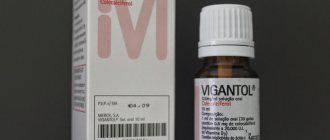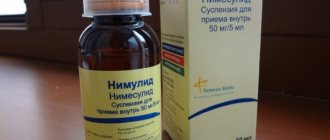Buy Bromhexine solution for internal use 4mg/5ml 60ml Berlin-Chemie in pharmacies
Bromhexine 4 Berlin-Chemie Buy Bromhexine 4 Berlin-Chemie in pharmacies DOSAGE FORMS solution 4mg/5ml solution for internal use 4mg/5ml
MANUFACTURERS Berlin-Chemie AG (Germany) Berlin-Chemie AG/Menarini Group (Germany)
GROUP Mucolytic agents
COMPOSITION Active ingredient: Bromhexine.
INTERNATIONAL NON-PROPENTED NAME Bromhexine
SYNONYMS Bisolvon, Bromhexine, Bromhexine 8, Bromhexine 8 Berlin-Chemie, Bromhexine Nycomed, Bromhexine-Acri, Bromhexine-UBF, Bromhexine hydrochloride, Bronchosan, Bronchotil, Solvin, Phlegamine
PHARMACOLOGICAL ACTION Mucolytic, expectorant, antitussive. Causes depolarization of mucoprotein and mucopolysaccharide polymer molecules (mucolytic effect). Stimulates the production of endogenous surfactant, which ensures the stability of alveolar cells during breathing, their protection from unfavorable factors, improving the rheological properties of bronchopulmonary secretion, its sliding along the epithelium and the release of sputum from the respiratory tract. When taken orally within 30 minutes, it is almost completely absorbed. In plasma it binds to proteins. Penetrates through the BBB and placental barriers. In the liver it undergoes demethylation and oxidation. Excreted by the kidneys. May accumulate with repeated use.
INDICATIONS FOR USE Acute and chronic diseases of the bronchi and lungs with impaired sputum discharge.
CONTRAINDICATIONS Hypersensitivity, pregnancy (especially in the first trimester), breastfeeding (must be suspended for the period of treatment).
SIDE EFFECTS Gastrointestinal disorders (nausea, vomiting, dyspepsia, exacerbation of peptic ulcer), increased aminotransferase activity, allergic skin reactions, angioedema.
INTERACTION Codeine -containing drugs make it difficult to clear liquefied sputum. Promotes the penetration of antibiotics (erythromycin, cephalexin, oxytetracycline) into the lung tissue.
METHOD OF APPLICATION AND DOSAGE Orally, with liquid. Adults and adolescents over 14 years old - 23-47 drops 3 times a day; children from 6 to 14 years old and patients whose body weight is below 50 kg - 23 drops 3 times a day, up to 6 years - 12 drops 3 times a day. Patients with severe renal failure should reduce the single dose or increase the interval between doses.
OVERDOSE No data available.
SPECIAL INSTRUCTIONS Prescribed with caution for peptic ulcers of the stomach and duodenum.
STORAGE CONDITIONS List B. In a place protected from light at room temperature.
Bromhexine 4 Berlin-Chemie solution for oral administration 4 mg/5 ml vial. 60 ml. 14970
Indications
Diseases of the respiratory tract accompanied by the formation of difficult-to-discharge viscous secretions: tracheobronchitis, chronic bronchitis with a broncho-obstructive component, bronchial asthma, cystic fibrosis, chronic pneumonia.
pharmachologic effect
Mucolytic agent with expectorant action. Reduces the viscosity of bronchial secretions by depolarizing the acidic polysaccharides it contains and stimulating the secretory cells of the bronchial mucosa, which produce secretions containing neutral polysaccharides. It is believed that bromhexine promotes the formation of surfactant.
Drug interactions
Bromhexine is incompatible with alkaline solutions.
Dosage regimen
Orally for adults and children over 10 years old - 8 mg 3-4 times a day. Children under 2 years of age - 2 mg 3 times a day; at the age of 2 to 6 years - 4 mg 3 times a day; at the age of 6 to 10 years - 6-8 mg 3 times a day. If necessary, the dose can be increased for adults to 16 mg 4 times a day, for children - up to 16 mg 2 times a day.
In the form of inhalations, adults - 8 mg, children over 10 years old - 4 mg, aged 6-10 years - 2 mg. At the age of up to 6 years - used in doses of up to 2 mg. Inhalations are carried out 2 times a day.
The therapeutic effect may appear on days 4-6 of treatment.
Parenteral administration is recommended for treatment in severe cases, as well as in the postoperative period to prevent the accumulation of thick sputum in the bronchi. Administer 2 mg subcutaneously, intramuscularly or intravenously 2-3 times a day slowly over 2-3 minutes.
Contraindications for use
Hypersensitivity to bromhexine.
Use in children
Use with caution in children - according to indications, in doses and dosage forms recommended according to age.
Restrictions for children
Use with caution
Restrictions for elderly patients
No data
Use for liver dysfunction
Use with caution in patients with impaired liver function.
Restrictions for liver dysfunction
Use with caution
Use during pregnancy and breastfeeding
Use is contraindicated in the first trimester of pregnancy. Use in the II-III trimesters of pregnancy and during breastfeeding is possible only in cases where the expected benefit to the mother outweighs the potential risk to the fetus or infant.
Restrictions when breastfeeding
Contraindicated
Restrictions during pregnancy
Use with caution
Use for renal impairment
Use with caution in patients with impaired renal function.
Restrictions for impaired renal function
Use with caution
special instructions
For gastric ulcers, as well as when there is a history of gastric bleeding, bromhexine should be used under the supervision of a physician.
Use with caution in patients suffering from bronchial asthma.
Bromhexine is not used simultaneously with medications containing codeine, because this makes it difficult to cough up thin mucus.
Used as part of combination preparations of plant origin with essential oils (including eucalyptus oil, anise oil, peppermint oil, menthol).
Side effect
From the digestive system:
dyspeptic symptoms, transient increase in the activity of liver transaminases in the blood serum.
From the side of the central nervous system:
headache, dizziness.
Dermatological reactions:
increased sweating, skin rash.
From the respiratory system:
cough, bronchospasm.
Possible product names
- Bromhexine 4 Berlin-Chemie solution for oral administration 4 mg/5 ml vial. 60 ml.
- BROMHEXINE 4 MG/5 ML SOLUTION 60 ML
- BROMHEXINE 4 BERLIN-CHEMIE 0.004/5ML 60ML SR D/VN.
- BROMOHEXINE 4-BERLIN-CHEMI solution 0.08% 60 ML X1
- BROMHEXINE 4 BERLIN-CHEMIE SR D/ORAL 4MG/5ML FL. 60ML
- BROMOHEXINE 4 BERLIN-CHEMIE RR D/PR. ORAL 4MG/5ML 60ML FL. B M (TORNED SECOND PACK
- (Bromhexine 4 Berlin-Chemie) Bromhexine 4 Berlin-Chemie oral solution 4 mg/5 ml vial. 60 ml.
Types of inhalers
The inhalation therapy method is based on the penetration of medicinal substances into the respiratory tract in the form of an aerosol, that is, tiny particles suspended in a gaseous medium. If aerosol is inhaled:
- particles larger than 5 microns settle in the oral cavity and upper respiratory tract;
- particles from 1 to 5 microns settle in the lower respiratory tract;
- particles with a diameter less than 1 micron are exhaled back.
Inhalers are divided into types depending on the mechanism of particle formation.
Ultrasonic nebulizers
In ultrasonic inhalers, the drug is atomized due to high-frequency vibration of piezoelectric crystals.
Research shows that ultrasonic inhalations are effective due to the spraying of not only the medicinal substance itself, but also negatively charged particles, which have an additional anti-inflammatory effect.
However, this type of inhaler has a drawback: exposure to ultrasound destroys many medications (for example, antibiotics and phlegm thinners).
Compressor inhalers
A compressor inhaler converts the drug into a fine aerosol using compressed air from a compressor.
The compressor inhaler is considered the most effective for affecting all parts of the respiratory tract. Its great advantage is the creation of an aerosol suspension with a very small particle size of the drug substance. You can use any medications that are intended for inhalation.
Steam inhalers
Based on the evaporation of medicinal substances under the influence of high temperatures.
Flaws:
- you can get a burn to the mucous membrane;
- affect only the upper respiratory tract;
- at high heating temperatures they reduce the biological activity of medicinal substances.
In medical practice, two types of inhalers are usually used: compressor and ultrasonic.
How to perform inhalations
- Inhalation is carried out no earlier than 1-1.5 hours after a meal or after physical activity.
- Smoking before and after inhalation is prohibited.
- It is advisable to gargle with plain water before inhalation.
- For diseases of the nose and nasopharynx, inhalation and exhalation are done through the nose using nasal cannulas.
- For diseases of the lower respiratory tract (bronchi, trachea), you need to use a special mouthpiece. During the procedure, you need to take a deep breath, hold your breath for a couple of seconds, and then exhale through your nose.
Use of inhalations
- For the prevention of respiratory diseases and moisturizing the mucous membrane of the respiratory tract.
- Treatment of bronchial asthma, chronic bronchitis, cystic fibrosis, COPD.
- In the complex treatment of rhinitis, sinusitis, pharyngitis, tracheitis, bronchitis.
- For children and the elderly.
- For patients with severe illnesses.
Causes and treatment of cough
Benefits of inhalation
- Direct delivery of the drug to the area of inflammation.
- Pure substance without impurities.
- Possibility to introduce any amount of dosed substance.
- Fast, instant action of the drug.
- Fewer side effects, since the drug does not enter the blood.
- Permitted for use in infancy, in postoperative conditions, and in coma.
- Maximum efficiency at the lowest cost.
Contraindications
Inhalations are not recommended for:
- elevated body temperature;
- cardiovascular failure;
- nosebleeds;
- emphysema;
- oncological diseases.
Bromhexine syrup
Release form
Syrup 8 mg/5 ml or syrup 4 mg/5 ml. Transparent, colorless or slightly yellowish with the smell of vanillin.
Compound
Active ingredient : bromhexine hydrochloride (80 mg or 160 mg per 100 ml of syrup).
Excipients : propylene glycol, sodium benzoate, food grade sorbitol, citric acid monohydrate, saccharin (sodium saccharinate), vanillin, purified water.
Production
- ROZFARM, LLC (Russia)
- ROZLEKS PHARM, LLC (Russia)
- Scan Biotech Ltd. (India)
Package
Syrup for oral administration, 50 ml or 100 ml in dark bottles made of polyethylene terephthalate or glass. Each bottle is placed together with instructions for use, a 5 ml measuring spoon or a 5 ml measuring cup in individual cardboard packs.
Pharmacological group
Mucolytic and expectorant drug
Action
Secretomotor, secretolytic, weak antitussive.
Bromhexine: description of the substance
Indications
Acute and chronic diseases of the respiratory tract, accompanied by difficulty in the discharge of viscous sputum: tracheobronchitis, bronchitis of various etiologies (including complicated by bronchiectasis), pneumonia, bronchial asthma, pulmonary tuberculosis, cystic fibrosis.
Sanitation of the bronchial tree in the preoperative period and during therapeutic and diagnostic intrabronchial manipulations, prevention of accumulation of thick viscous sputum in the bronchi after surgery.
Application and dosage
Inside. 1 measuring spoon or 1 measuring cup contains 5 ml of syrup.
Syrup 8 mg/5 ml is prescribed:
- adults and children over 14 years old, 8–16 mg (5–10 ml) 3 times a day,
- children 6–14 years old - 8 mg (5 ml) 3 times a day.
Syrup 4 mg/5 ml is prescribed to children in the following doses:
- up to 2 years 2 mg (2.5 ml) 3 times a day,
- 2–6 years - 4 mg (5 ml) 3 times a day,
- 6–14 years - 8 mg (10 ml) 3 times a day.
Contraindications and restrictions
Hypersensitivity, peptic ulcer of the stomach and duodenum, pregnancy (first trimester), lactation period, children under 6 years of age (for syrup 8 mg/5 ml).
With caution : renal failure, liver failure, bronchial diseases accompanied by excessive accumulation of secretions, a history of gastrointestinal bleeding.
Side effects
Allergic reactions, nausea, vomiting, dyspepsia, exacerbation of gastric and duodenal ulcers, dizziness, headache, increased activity of liver transaminases (extremely rare).
Overdose
Symptoms: nausea, vomiting, diarrhea and other dyspeptic disorders. Treatment: artificial vomiting, gastric lavage (in the first 1–2 hours after administration).
special instructions
During treatment, it is necessary to consume a sufficient amount of fluid, which increases the expectorant effect of bromhexine.
Treatment should be combined with postural drainage or vibration massage of the chest, which facilitates the removal of secretions from the bronchi.
Bromhexine does not contain sugar; the syrup contains sweeteners, so it can be used in patients with diabetes and obesity.
Storage
Store in a dry place, protected from light, out of reach of children, at room temperature not lower than 15°C. Shelf life: 3 years.
Recipe
Available without a prescription.




